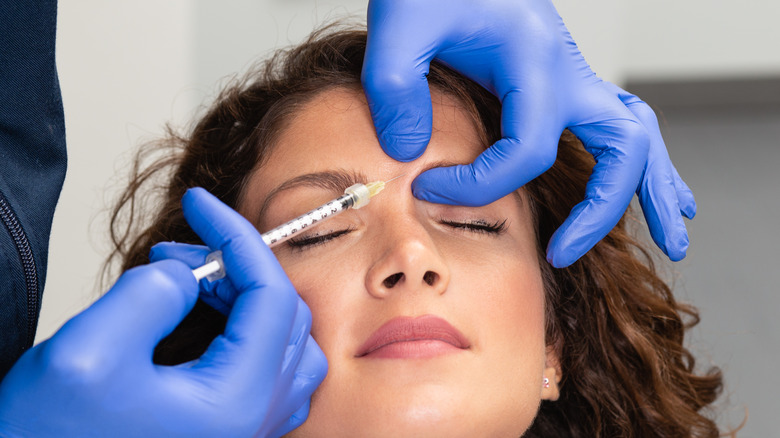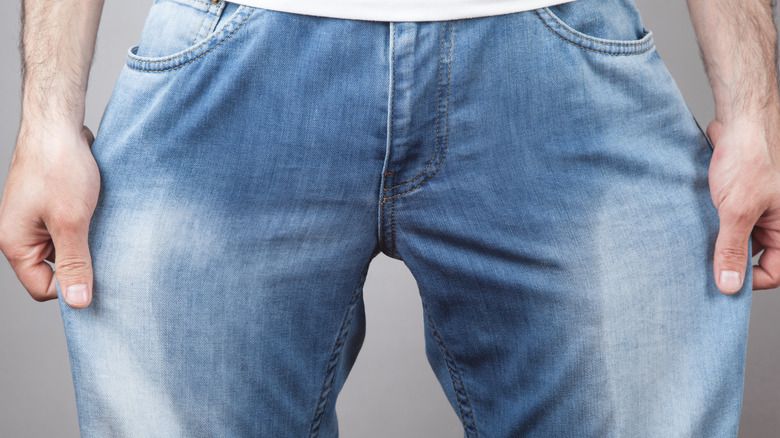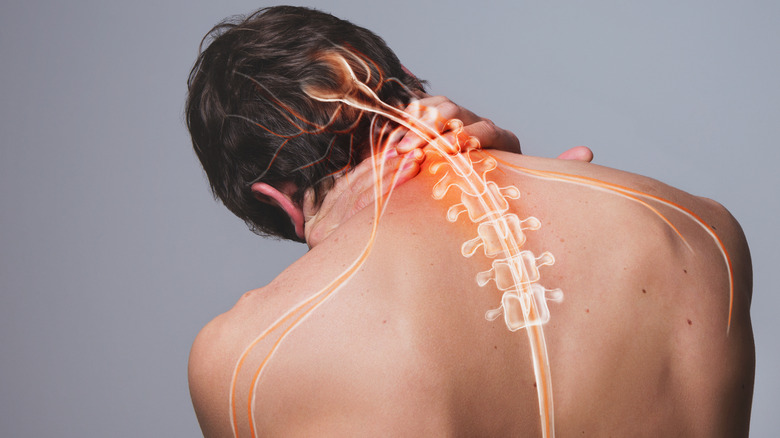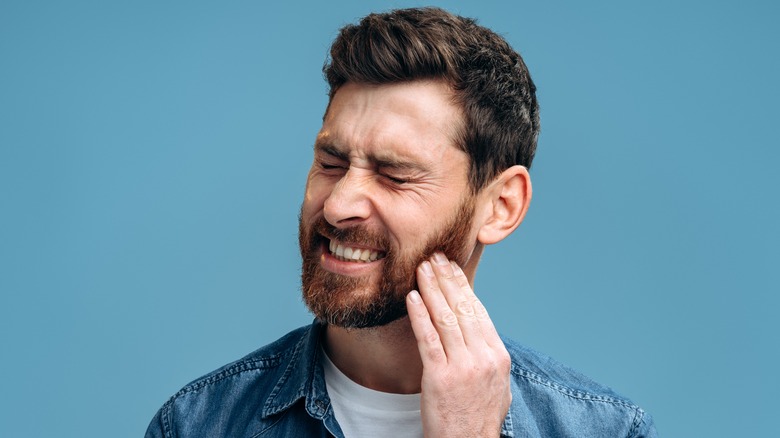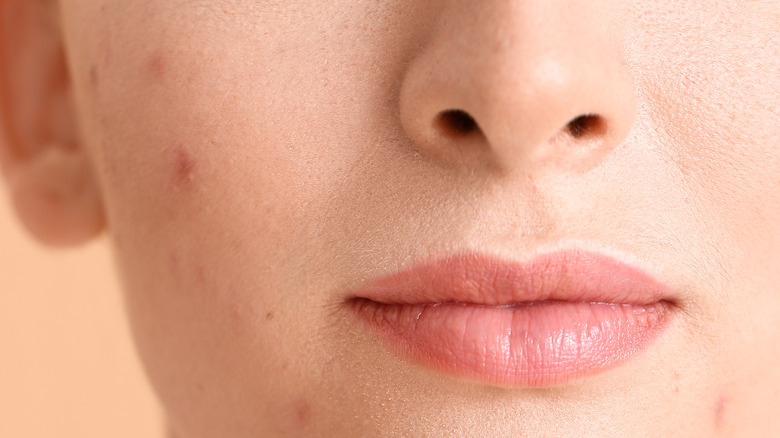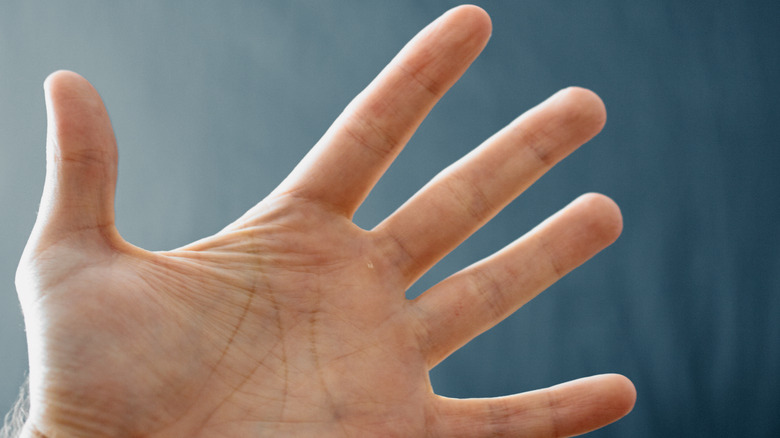Unexpected Conditions That Can Be Treated With Botox
Botox was the first drug to use botulinum toxin to reduce the appearance of facial wrinkles, according to the Mayo Clinic. Derived from onobotulinumtoxinA, when injected, Botox causes short-term relaxation or paralysis of the muscles in the targeted area (via MedlinePlus). But while this treatment is most commonly associated with cosmetic use to combat signs of aging, medical advancements have allowed Botox to progress far beyond its initial purpose. In fact, the medical community has developed many other FDA-approved and off-label uses for Botox (via Dermatology Centers). Botox is now used to treat a variety of conditions, some of which may surprise you.
The Mayo Clinic emphasizes the importance of selecting a trained medical provider in the area where you need Botox treatment. This is especially important because Botox can have serious side effects if injected incorrectly. These side effects will differ depending on the site of treatment. According to the American Academy of Ophthalmology, Botox injections can last up to six months and require repeated injections to maintain the benefits of therapy as the toxin wears off.
Strabismus
Strabismus, also known as crossed eyes, is a condition in which the muscles that control eye movement do not work together, and one eye is misaligned (via American Optometric Association). Each eye has six muscles that control eye movement. These muscles are responsible for the eye moving in all directions. Both eyes should always move together, so they focus on one thing simultaneously. When one of the muscles in either eye is weak, the synergy breaks down, resulting in strabismus.
Botox was approved by the FDA in 1989 for the treatment of strabismus, according to a study published in Seminars in Ophthalmology. Botox therapy is a technique used to inject medication directly into the affected eye muscles (per Fiala Aesthetics). The eye muscle is thus paralyzed and relaxes to allow for realignment. This relaxation is usually temporary, lasting up to four months. In some cases, though, Fiala Aesthetics notes that a Botox injection will permanently elongate the affected muscle, leading to a long-term solution.
Chronic migraines
The FDA approved Botox injections for the treatment of chronic migraines in 2010. According to the American Migraine Foundation, there are several factors to consider before deciding whether Botox treatments are appropriate for your condition. First and foremost, Botox is only FDA-approved for treating chronic migraines. This means that your migraines must occur at least 15 days per month. Dr. Andrew Blumenfeld, Director of The Headache Center of Southern California, reports to the American Migraine Foundation that Botox is not recommended if your migraines are less frequent.
According to Johns Hopkins Medicine, it may take up to a month for the Botox injections to have full effect and reduce migraine occurrence and pain. Botox is injected into several areas around the head and neck as determined by your healthcare provider. It is thought that the botulinum toxin interferes with the pain pathway from the head to the spine, and thus provides relief from migraine pain.
Urinary incontinence
Urinary incontinence can manifest in various ways in both men and women (via the Mayo Clinic). You may need to pee more frequently than usual — eight or more times a day — or have your sleep interrupted multiple times a night due to the need to urinate. The need to pee may come on urgently, and you may find it hard to hold in your urine. If you experience any form of urinary incontinence, you are not alone. According to Urology Care Foundation, up to a third of men and women have a form of urinary incontinence.
Botox is an FDA-approved treatment that may be recommended if conservative measures such as medication, fluid restrictions, or pelvic exercises fail to treat urinary incontinence (via the Cleveland Clinic). Urologist Sandip Vasavada tells the Cleveland Clinic that 70-80% of people who receive Botox injections for urinary incontinence report that the treatment was effective in relieving their symptoms.
According to Advanced Gynecology, Botox is a quick procedure performed in an outpatient setting, such as a physician's office. After a local anesthetic is administered, the medication is injected into the bladder muscle. In most cases, you can drive yourself to and from the procedure. The procedure will take approximately one hour, including a thirty-minute post-procedure evaluation time. Most people will have no side effects and will notice an improvement in their symptoms after two weeks. However, the full effect of symptom relief may take up to three months. Injections are recommended twice a year.
Excessive sweating
Sweating is the body's way of controlling internal temperature, but there is a condition that can cause you to sweat too much. Excessive underarm sweating, also known as hyperhidrosis, occurs when there is no underlying medical condition and the body is not experiencing a temperature rise (via the Mayo Clinic). Some people may find this condition embarrassing. Many people are unaware that excessive sweating can be controlled.
The International Hyperhidrosis Society reports that the FDA approved the use of Botox in 2004 to treat excessive underarm sweating with no secondary cause. Botox injections under the arm have been shown to reduce underarm sweating by up to 87%. The injections can last up to 12 months, and the results are visible within the first week.
According to the Cleveland Clinic, the body will still sweat after Botox injections — just at a more appropriate level. You will still need to use deodorant, but you will be relieved to know that body odors should be reduced. Also, it's important to note that Botox is occasionally used for other areas of the body that may experience increased sweat production, such as the feet, groin, head, and underneath the breasts. Treatment for these areas can be more painful and may produce side effects. Therefore, Botox is not FDA-approved for use in these areas.
Rectal disorders
One of the muscles that control when you poop is the internal anal sphincter (via Cleveland Clinic). This muscle is constantly under pressure and can tear if the pressure in this area is excessive. An anal fissure can form as a result, causing pain and bleeding. Given the location of the tears, they are difficult to heal. Botox may be considered for temporary treatment if dietary changes, stool softeners, or topical medications do not help.
A study published in African Health Sciences reports that treating anal fissures with Botox injections was effective in 89% of patients with chronic anal fissure. In this case, the injections may help to avoid surgery to repair the wound. It is important to note that the use of Botox for rectal disorders, including anal fissure treatment, has not been approved by the FDA and is currently being researched. The results, however, are encouraging.
Furthermore, Nationwide Children's reports that Botox injections around the anal sphincter are becoming more common in children with long-term chronic constipation caused by underlying medical conditions. Botox is effective in treating these situations by relaxing the anal sphincter. Although this is a temporary remedy, researchers at Nationwide Children's Hospital have found it to be a safe option.
Male sexual dysfunction
Male sexual dysfunction can include both premature ejaculation and erectile dysfunction. As Weill Cornell Medicine notes, though these problems are common, they can be hard to discuss. However, it's important to bring these issues up with your doctor, as they might be signs of other underlying health issues, and can also be treatable. As it turns out, Botox may be a potential treatment option.
According to the Mayo Clinic, men may experience premature ejaculation if they ejaculate one to three minutes after penetration consistently or if they are unable to delay ejaculation while having sex. However, one small clinical study reported longer ejaculation times for the group that received Botox injections than those in the control group. While the results show promise for this treatment option, the authors note that more study is needed.
In addition, Botox is sometimes used off-label to treat erectile dysfunction, an issue which causes someone to struggle to get or sustain an erection (per the Mayo Clinic). When injected into the penis, Botox relaxes the blood vessels, allowing more blood to flow to the penis, according to Pollock Clinics. Botox also prevents nerve impulses from causing muscles to contract, resulting in longer-lasting erections. Botox may be an option for erectile dysfunction if other treatments fail. In this case, Botox will be effective for up to four months, and repeat treatment will be required to maintain the positive effects.
Cervical dystonia and neck pain
Suppose you endure chronic neck pain, or from the muscle spasms known as dystonia, and cannot find relief through therapy, medication, or other modalities. In that case, Botox injections may be beneficial (via Omni Spine Pain Management).
According to Rush University, Botox injections effectively treat the symptoms of spasticity and abnormal neck tightness caused by conditions such as multiple sclerosis, spinal cord injuries, and cerebral palsy among others. Botox helps to relax the stiff muscles in these examples, and can therefore relieve symptoms, but it is not a cure for the underlying health issue.
Furthermore, a study published in Anesthesia & Analgesia found that injecting Botox into the neck and shoulder muscles where the pain is located, rather than using trigger points as in traditional pain therapy, resulted in lower pain levels and fewer headaches. This study also found that patients who received Botox therapy for neck pain and muscle stiffness had a higher quality of life. Improved sleep, mood, and overall stress relief have been reported by patients. It is essential to note, though, that continuous Botox therapy is required every three to six months, depending on how someone's body metabolizes the medicine.
TMJ
TMJ (temporomandibular joint disorder) can be highly unpleasant. The TMJ Association describes symptoms as pain on one or both sides of the jaw, decreased movement, or difficulty opening your mouth wide. Furthermore, you may hear a clicking sound or feel a popping or cracking when moving your jaw. You may also clench or grind your teeth, which may cause inflammation in this area. The severity of these symptoms varies, and some may disappear with time. Others may experience impairing and long-term symptoms. Your doctor may prescribe anti-inflammatory medication, pain relievers, or muscle relaxants for your symptoms. Furthermore, certain mouthguards or physical therapy visits may be beneficial (per the Mayo Clinic).
However, Rejuvenation Dentistry states that Botox may be a viable next step if traditional methods fail. Botox can be injected into the muscles along your jaw, forehead, and temples, depending on your symptoms. The FDA has not approved Botox for the treatment of TMJ, but it is proving to be beneficial in off-label uses for TMJ symptoms. As with other Botox-treated conditions, the effects of the Botox will wear off after a few months and additional treatments may be necessary.
Acne and acne scarring
Botox, well-known for its cosmetic abilities in wrinkle reduction, can also help reduce acne and acne-related scars, according to Schweiger Dermatology Group. Acne is caused by an excess of oil, which can accumulate and breed bacteria, clogging pores in the hair follicles beneath the skin (via the National Institute of Arthritis and Musculoskeletal and Skin Diseases). These clogged pores cause red, inflamed bumps which may contain a pus-like substance. Acne is more common in teenagers and young adults under 30.
Botox, when injected in the face, blocks the production of acetylcholine. Because acetylcholine is blocked, the sebum or oil production is also blocked, slowing the formation of acne. Even though this may sound like the answer for teenage acne, Dr. Corinne Horn of the NY Facial Plastic Surgery Center states Botox should only be used in patients older than 20, so their hormones levels are more stable. Furthermore, a study published in the Journal of Cutaneous and Aesthetic Surgery reports that Botox can improve the appearance of acne scarring, as other kinds of scars as well.
Heart arrhythmia after open heart surgery
Botox is an effective treatment for various ailments with many surprising applications. However, the use of Botox in cardiovascular patients undergoing coronary artery bypass grafting (CABG) surgeries is one of the most intriguing and potentially lifesaving. According to tctMD, post-operative arrhythmias occur in 11-40% of open-heart surgery patients. An abnormal heart rhythm following surgery can reduce a patient's long-term survival rate.
However, the American College of Cardiology reports that when Botox is injected into the fat pads around the heart during open heart surgery, the arrhythmia, more commonly known as atrial fibrillation or A-fib, is significantly reduced immediately following surgery and throughout the first year. A small study revealed that patients who received Botox injections had no episodes of A-fib after one month through the first year after surgery, compared to 27% in the group that did not receive Botox during surgery.
According to Science Daily, more research is being conducted into the use of Botox during open heart surgery, and this treatment is not FDA-approved. If the study's results can be replicated in larger populations, the hope is to expand the use of Botox in other heart surgeries, such as valve replacements, where postoperative heart arrhythmias are common.
Raynaud's syndrome
Raynaud's syndrome is a condition that causes the small blood vessels in the extremities to contract and constrict when they encounter a cold environment, per the Raynaud's Association. When this happens, the vessels spasm. As a result, pain, numbness, and throbbing may occur, as well as discoloration of the fingers or toes. Raynaud's impacts up to 10% of the population.
UVA Health notes that Botox injections with image guidance via ultrasound technology have been shown to reduce Raynaud's symptoms in those who experience them frequently. The ultrasound guidance aids in viewing a more accurate location to inject the Botox, reducing the risk of side effects such as hand weakness that can occur without imaging assistance. The injections relax the muscles surrounding the blood vessels, allowing more consistent blood flow to the affected extremities (via the University of Chicago Medicine). Botox can relieve symptoms for up to three months.
Vaginismus
Females who have painful intercourse may be embarrassed to discuss it. However, according to the Women's Wellness Institute of Dallas, vaginismus is a medical condition that frequently causes this dreaded experience.
Vaginismus occurs when the vaginal muscles spasm when something is inserted, such as during a medical exam, tampon insertion, with a penis, or even a finger, per the Cleveland Clinic. This tightening or spasm is not voluntary, and it is uncontrollable. When this happens, the spasms can cause mild to severe pain.
A clinical trial using Botox injections into the vaginal wall on people with vaginismus produced positive results (per the U.S. National Library of Medicine). Although the treatment required assistive modalities and anesthesia, it was effective for most of the women in the trial. Under anesthesia, multiple-size dilators were used to visualize where muscle contractions occur. Botox was injected into the targeted areas. Local numbing medications were also applied to the dilators, and long-acting local anesthesia was injected into the vaginal wall. The patients awoke with a large dilator in place that they would practice moving in and out. Counseling was provided, and most patients were able to engage in pain-free intercourse by the time of the one-year follow-up.
Excessive drooling in the pediatric population
Excessive drooling can be dangerous in children with neurological disorders like cerebral palsy, myasthenia gravis, and other neuromuscular diseases (via Paediatrics Childs Health). Due to their conditions, some children have difficulty swallowing and may choke due to excessive saliva production. Others may be embarrassed by excessive drooling.
According to an article published in the Journal of Neurology, Neurosurgery, and Psychology, the standard treatment for excessive drooling is typically pharmaceutical, which can cause unwanted side effects. In severe cases, irradiation of the parotid gland is necessary. However, an article published in the Journal of Pediatrics states that Botox is a safe and effective treatment that is less invasive than surgical procedures. Sedation and imaging are usually required to ensure the child's comfort during the injections. The Botox treatment is only temporary and must be repeated after a few months, and more research is needed to improve treatment dosing accuracy and frequency.

